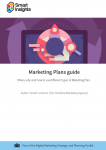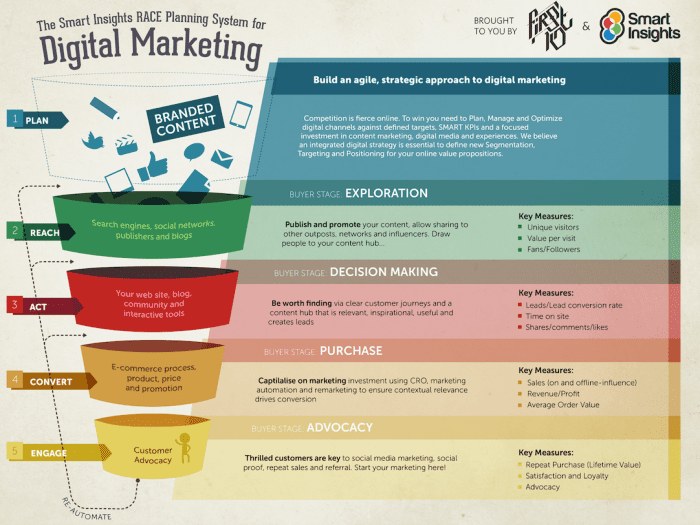What are the essential parts of a multichannel marketing plan template?
Multichannel marketing is the process of utilizing online and offline marketing communications channels to target and engage with your customers.
As outlined in our Quick Win – Create a Multi-Channel Marketing Plan, the purpose of a multichannel marketing plan is to define a strategy and plan the resources needed to achieve business sales targets. The timeframe is typically annual but potentially longer-term, such as 18 months to three years.
Examples of communications channels could include, for example:
- Websites
- Physical stores
- Catalogues
- E-mail marketing
- TV
- Text messaging
- Blogging
- Direct mail
The goal is to deliver leads and sales targets for defined products and services, which can apply to an organization as a whole, or a single market if there are multiple markets and product or service categories.
An effective multichannel marketing plan outlines the marketing communications techniques and channels required in order to enable customer acquisition for particular product or service categories. A multichannel marketing plan strategically connects multiple channels together into one, thriving, multi-channel communications approach.
When to use it?
The key to a successful multichannel marketing plan is integration; a common challenge that most marketers face. If your organization has established a digital marketing plan, for example, it should not be used in isolation, but used to inform the multichannel marketing planning process.
Your multichannel marketing plan should set out campaigns that span multiple channels, catering to the customer and tailoring them to fit multiple channels. Buying processes are controlled by the customer, rather than the marketer so the ‘always-on’ nature of multichannel marketing will reach customers via the inbound or outbound channel of their choice.
Organizations using an effective integrated multi-channel marketing plan will continuously stand out, gain qualified leads and maximize conversion throughout the customer lifecycle. Your multichannel marketing plan should therefore continually engage, nurture and retarget customers in order to convert to sale.
What should be included in a multichannel marketing plan?
A multichannel marketing plan typically includes:
- Detailed customer profiles and relevant marketing communication channels for each
- SMART objectives for acquiring or retaining customers
- Marketing tactics including content marketing with an inbound focus
- The integrated marketing communications channels to be utilized, across multiple platforms and devices, in order to attract and convert customers
- How multichannel results will be measured for effectiveness, influence and exclusion
Knowing which campaigns on which channels has led to the most sales will enable you to establish the success of your activities and the return on investment (ROI) that particular channel returns. Customers move across channels quickly, therefore both your strategy and analytics should simultaneously adapt.
Introducing SOSTAC® and RACE
For the perfect multichannel plan structure, I recommend you combine SOSTAC® and RACE planning. Why are two frameworks better than one, when we’re seeking simplicity? The reason is that each has their own strengths.
SOSTAC® is structured around process covering all stages of creating and implementing your plan including goal-setting, strategy, implementation and review.
RACE Planning is structured around the many activities in the modern marketing funnel designed to define online and offline tactics to engage audiences to get results.
So, you can see that the strength of SOSTAC® as a general planning framework is also a weakness; it doesn’t apply specifically to the multichannel marketing communications needed to engage an audience through an engagement funnel.
Applying SOSTAC® to multichannel marketing plans
To make sure your multichannel marketing plan has all the essential features, I recommend the SOSTAC® structure developed by PR Smith—Dave Chaffey’s co-author of the printed book Digital Marketing Excellence.
SOSTAC® is a great framework for structuring business, marketing or digital marketing plans since it’s relatively simple and logical, so it’s easy to remember and to explain to colleagues or agencies. SOSTAC® is a strategic planning process framework that gives you a clear structure to work through to create and manage your plan.
Situation analysis means ‘Where are we now?’ For multi-channel marketers, questions include:
- Are we measuring results accurately through analytics?
- Which type of prospects are we reaching online?
- What are our competitors doing?
- What’s working for them?
Objectives mean ‘Where do we want to be?’
- What is the growth forecast?
- What are the top-level goals 5 Ss (Sell, Serve, Speak, Save and Sizzle)?Plus, we can build specific forecasts for leads and sales by channel to hit the business plan target. Good objectives are quantified against timescales.
Strategy means ‘How do we get there?’ Strategy summarizes how to fulfill the objectives. It is the shortest part of the plan, but arguably, the most important, as it gives direction to all the subsequent tactics. It answers questions including:
- Which segments will be targeted with which propositions?
- What positioning will we choose?
- How will leads and sales targets be achieved?
- Which channels should we focus our media investment on?
- What communications strategies will be used to support customer acquisition, conversion and retention?
Tactics are the details of strategy (the marketing mix, communications mix and channel mix are the tactical tools). They highlight on a campaign timeline exactly which tactics occur when. For example, how do we improve our ‘always-on’ communications, e.g. how to harness Marketing Automation alongside Content Marketing to generate and nurture leads.
To help you plan your multichannel marketing tactics effectively, the RACE Planning system will provide you with a simple framework.
RACE covers the full customer lifecycle or marketing funnel from:
(Plan) > Reach > Act > Convert > Engage
There is also an initial phase of Plan involving creating the overall digital strategy, objective setting and plan.
RACE consists of four steps or online marketing activities designed to help brands engage their customers throughout the customer lifecycle. This infographic shows the goals for each part of RACE and how you can measure them.
- Reach.
Reach involves building awareness and visibility of your brand, products and services on other websites and in offline media in order to build traffic by driving visits to different web presences like your main site, microsites or social media pages. It involves maximising reach over time to create multiple interactions using different paid, owned and earned media touchpoints. - Act.
Act is short for Interact. It’s a separate stage from conversion since encouraging interactions on websites and in social media. For most businesses the main aim of Act is to generate online leads. So, it’s about persuading site visitors or prospects take the next step, the next Action on their customer journey when they initially reach your site or social network presence. It may mean finding out more about a company or its products, searching to find a product or reading a blog post.You should define these actions as top-level goals of the funnel in analytics. Goals can include “Viewed product”, “Added to Basket”, “Registered as member” or “Signed up for an e-newsletter. Act is also about encouraging participation. This can be sharing of content via social media or customer reviews (strictly, part of Engage). - Convert.
This is simply conversion to sale, online or offline. It involves getting your audience to take that vital next step which turns them into paying customers whether the payment is taken through online Ecommerce transactions, or offline channels. - Engage.
This is long-term customer engagement and communications that is, developing a long-term relationship with first-time buyers to build customer loyalty as repeat purchases using communications on your site, social presence, email and direct interactions to boost customer lifetime value. It can be measured by repeat actions such as repeat sale and sharing content through social media. We also need to measure percentage of active customers (or email subscribers) and customer satisfaction and recommendation using other systems.
The Smart Insights Multichannel Marketing Growth Wheel infographic gives a visual view of key planning activities that are needed as part of the process of producing an integrated digital marketing plan.
A solid digital marketing plan has:
- Clear, realistic goals which you can be confident of hitting
- The best strategy to achieve these goals against your competition
- Sufficient details of the tactics and actions needed to translate the strategy into action
- A method to check you are on track with your plans
Which type of business is a multichannel marketing plan most suited for?
A multichannel marketing plan is suited to:
- Small to medium-sized businesses (SME/SMB) as an annual communications plan
- Larger businesses as an annual communications plan for one market or audience
It can also act as a longer-term customer engagement plan, focusing on one market or audience.
For larger organizations, formulating multichannel marketing plans is typically challenging, owing to obstacles when attempting to:
- Centralize goals
- Achieve coherent customer relationship management (CRM)
- Co-ordinate messaging across departments, brands and business units
- Achieve consistency across channels
- Measure frequency and reach of activities
How does a multichannel marketing plan relate to other plans?
A multichannel marketing plan is a marketing communications plan, rather than a broader marketing plan. Key outputs include:
- Marketing objectives
- Marketing budget
- Campaign plans
- Resource plans
Integration with other organizational plans is critical in order to connect them all together into one, strategic, multi-channel approach to inbound marketing. Integrated with a multichannel marketing plan may be a marketing plan, digital marketing plan and a campaign plan, for example. They inform the multichannel marketing plan and vise-versa.
Effective integration and compilation will result in a long-term integrated communications plan for utilizing all of your marketing activities together, in order to hit lead and sales targets.
source https://www.smartinsights.com/online-brand-strategy/multichannel-strategies/structure-effective-multichannel-marketing-plan/


No comments:
Post a Comment